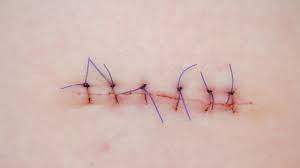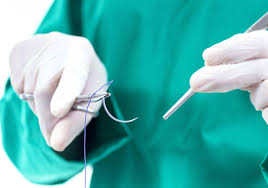
Essential Suture Care Tips for Quick Healing
The Complete Guide to Sutures Care Tips for Healing Wounds Safely
Welcome to our comprehensive guide on sutures! Whether you’ve recently undergone surgery or sustained an injury requiring wound closure, proper care of your sutures is crucial for optimal healing. Here, we’ll provide you with easy-to-follow tips and best practices to ensure that your sutures receive the attention they need for a speedy recovery.
Sutures , also known as stitches, are commonly used medical devices used to close wounds or surgical incisions by bringing the edges of the skin or other tissues together. Proper care is essential to promote healing, prevent infection, and minimize scarring. They play a crucial role in the healing process by providing support and promoting proper wound healing. Whether you’ve just had sutures placed or you’re helping someone else with their wound care, this post will provide you with valuable tips and best practices for suture care.
Types of Sutures:
- Absorbable Sutures: are designed to dissolve over time and are often used for internal stitches or wounds that heal quickly. They eliminate the need for suture removal and are typically made from materials such as polyglactin, polyglycolic acid, or poliglecaprone.
- Non-Absorbable Sutures: are made from materials that are not absorbed by the body and require removal once the wound has healed. Common materials include nylon, polyester, silk, and stainless steel. They are suitable for wounds that require long-term support or in areas with high tension.
- Monofilament Sutures: consist of a single strand of material and are less prone to harboring bacteria than multifilament sutures. They are smooth and easy to handle but may have reduced tensile strength compared to multifilament sutures.
- Multifilament Sutures: are composed of several strands twisted or braided together. They offer greater tensile strength and knot security but have a higher risk of harboring bacteria. Common examples include silk and polyester sutures.
- Barbed Sutures: feature small barbs or projections along the length of the suture, allowing for a self-anchoring mechanism without the need for knots. They are often used in minimally invasive procedures and can provide excellent tissue approximation.
Uses of Sutures:
- They are used in various surgical procedures to close incisions made during surgery, promoting wound healing and reducing the risk of infection.
- They are commonly used to close lacerations or cuts, whether they occur due to accidents, trauma, or surgical interventions.
- Some are used internally to close deep tissue layers or organs during surgery, providing support and promoting healing without being visible externally.
Factors to Consider When Choosing Sutures:
- The choice of suture depends on the type of tissue being closed, such as skin, muscle, or internal organs.
- They should have adequate tensile strength to withstand the forces acting on the wound during the healing process.
- They should be biocompatible, meaning they do not elicit an adverse immune response or tissue reaction.
- For absorbable sutures, the rate of absorption should match the healing time of the tissue being sutured.
- They should be easy to handle and manipulate during placement to ensure proper wound closure and knot security.
Myths vs Facts:
Myth: Sutures should be removed as soon as possible to speed up the healing process.
Fact: They should only be removed when the wound has sufficiently healed, as determined by a healthcare professional. Premature removal can lead to wound dehiscence (opening) and increase the risk of infection or delayed healing.
Myth: Absorbable sutures don’t require any follow-up care.
Fact: While absorbable sutures dissolve over time, it’s still essential to monitor the wound for signs of infection or other complications. Follow-up care may be necessary to ensure proper healing and to address any issues that may arise.
Myth: All sutures are the same, so it doesn’t matter which type is used.
Fact: There are various types of sutures, each with its own characteristics and indications. Factors such as tissue type, location, and tension on the wound should be considered when choosing the appropriate suture material and type.
Myth: Sutures always leave noticeable scars.
Fact: While scarring is a natural part of the healing process, proper wound closure techniques and post-operative care can minimize the appearance of scars. Additionally, some sutures, such as those used in plastic surgery, are designed to reduce scarring.
Myth: Sutures can only be used on skin wounds.
Fact: They can be used to close wounds on various tissues, including skin, muscle, and internal organs. They are commonly used in surgical procedures to approximate tissues and promote healing.
Myth: Removing a suture is a painful process.
Fact: Suture removal is typically quick and relatively painless, especially when performed by a trained healthcare professional. The sensation may feel like a slight tug or discomfort, but it is usually well-tolerated by patients.
Myth: It’s okay to remove sutures at home.
Fact: They should only be removed by a healthcare professional to ensure that the wound has healed sufficiently and to minimize the risk of complications. Attempting to remove sutures at home can lead to injury or improper wound closure.
Myth: Sutures can be left in indefinitely without any consequences.
Fact: While some are designed to dissolve on their own, non-absorbable sutures may need to be removed to prevent complications such as infection or tissue reaction. It’s essential to follow your healthcare provider’s instructions regarding suture removal to promote proper healing.
Dos when dealing with sutures:
- Keep the wound clean: Cleanliness is paramount when caring for sutures. Wash your hands thoroughly with soap and water before touching the wound or changing dressings. Use a gentle cleanser and water to clean the area around the sutures daily, patting it dry with a clean towel.
- Follow your doctor’s instructions: Your healthcare provider will provide specific instructions on how to care for your wound, including when to change dressings, how to keep the wound dry, and when to remove the sutures. Adhere to these instructions carefully to promote proper healing.
- Change dressings regularly: Depending on the type of wound and your doctor’s recommendations, you may need to change dressings daily or as instructed. Use sterile gauze or dressing materials provided by your healthcare provider and secure them gently with medical tape.
- Keep the wound moist: While it’s essential to keep the wound clean and dry, maintaining a moist environment can promote healing and reduce scarring. Your doctor may recommend applying a thin layer of antibiotic ointment or petroleum jelly to the wound before covering it with a dressing.
- Monitor for signs of infection: Keep a close eye on the wound for any signs of infection, such as increased redness, swelling, warmth, or drainage with an unpleasant odor. If you notice any of these symptoms, contact your healthcare provider immediately.
- Protect the wound: Avoid activities that may put strain on the wound or increase the risk of injury. Keep the wound protected from friction, pressure, and direct sunlight, especially during the early stages of healing.

Don’ts when dealing with sutures:
- Don’t pick or scratch at the sutures: It may be tempting to scratch an itch or pick at the sutures, but this can disrupt the healing process and increase the risk of infection or scarring. Avoid touching the sutures unless necessary for cleaning or dressing changes.
- Don’t submerge the wound in water: While showering is usually permitted, avoid soaking the wound in water, such as swimming or taking baths, until your doctor gives you the green light. Water exposure can weaken the sutures and increase the risk of infection.
- Don’t apply excessive force: Be gentle when cleaning or handling the wound to avoid causing damage to the sutures or surrounding tissue. If you notice any bleeding or unusual pain during wound care, contact your healthcare provider for guidance.
- Don’t remove the sutures on your own: These are typically removed by a healthcare professional once the wound has sufficiently healed. Attempting to remove sutures yourself can cause injury or premature opening of the wound. Follow your doctor’s recommendations regarding suture removal.
- Don’t neglect follow-up appointments: Regular follow-up appointments with your healthcare provider are essential to monitor the healing progress and ensure that the sutures are removed at the appropriate time. Attend all scheduled appointments and communicate any concerns or issues with your doctor.
- Don’t delay seeking medical attention: If you experience severe pain, bleeding, pus-like discharge, or other concerning symptoms around the wound site, don’t hesitate to seek medical attention. Prompt treatment can prevent complications and promote optimal healing.
Proper care of your wound is essential for promoting healing and preventing complications after surgery or injury. By following these dos and don’ts and staying in close communication with your healthcare provider, you can ensure that your wound heals safely and effectively. Remember, patience and diligence are key to a successful recovery process.
Disclaimer: The information provided in this content is for general informational purposes only. It is not intended as medical or healthcare advice, diagnosis, or treatment. Always seek the advice of a qualified healthcare professional with any questions you may have regarding a medical condition or healthcare decisions.


